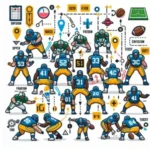In the high-octane world of American football, the offensive scheme is the heartbeat of any successful team, orchestrating the dynamic dance between strategy and execution.
As coaches and players gear up for the next season, understanding the intricacies of designing an effective offensive scheme becomes paramount. From the foundational principles of play-calling to the innovative adaptations that keep defenses guessing, mastering the game requires a keen grasp of key factors such as player strengths, defensive alignments, and situational awareness. In this blog post, we’ll delve into the essential elements that contribute to a formidable offensive strategy, exploring the art of creating mismatches, the importance of communication on the field, and the role of technology in modern football. Whether you’re a seasoned coach or an aspiring strategist, this guide will equip you with the insights needed to elevate your offensive game to new heights.
1. Understanding Offensive Philosophy: The Foundation of Your Scheme

When it comes to designing an effective offensive scheme in American football, understanding your offensive philosophy is not just a foundational step; it’s the very bedrock upon which your entire strategy will be built. Your offensive philosophy encompasses your core beliefs about how the game should be played, shaping everything from play selection to player roles and even game management.
At its essence, an offensive philosophy may lean towards a pro-style approach, favoring a balanced mix of run and pass plays, or it might embrace a spread concept, prioritizing speed and space to exploit mismatches against the defense. The choice you make here should reflect not only your personal coaching style but also the strengths and weaknesses of your roster. For instance, if your team boasts a strong offensive line and a powerful running back, a ground-and-pound philosophy that emphasizes the run game could be the most effective path to success. Conversely, if your quarterback is a dynamic playmaker with a strong arm, implementing a pass-heavy scheme could maximize your scoring potential.
Moreover, a well-defined offensive philosophy serves as a guiding light during the rigors of a season. It influences how you prepare for each opponent, dictating your game plan and play-calling tendencies. Consistency in philosophy helps players understand their roles and responsibilities, fostering a sense of unity and purpose on the field. It allows for adaptability, as you can adjust specific plays or formations while remaining true to your overarching principles.
As you embark on designing your offensive scheme, take the time to articulate your philosophy clearly. Consider questions such as: What are our strengths? How do we want to attack defenses? What tempo suits our personnel? By answering these questions, you’ll create a robust framework that not only informs your playbook but also inspires confidence in your players, setting the stage for a potent and cohesive offensive performance.
2. Identifying Your Team’s Strengths and Weaknesses
Identifying your team’s strengths and weaknesses is a critical step in designing an effective offensive scheme in American football. Every team is a unique amalgamation of talent, skills, and experience, and understanding these nuances can significantly influence your offensive strategy.
Begin this process with a comprehensive evaluation of your players. Analyze their physical attributes, technical skills, and mental acuity. For instance, if you have a fleet-footed quarterback with a strong arm, a vertical passing game that stretches the field might play to his strengths. Conversely, if your offensive line excels in run blocking but struggles in pass protection, a ground-and-pound approach could yield more success.
Equally important is recognizing your team’s weaknesses. Identify areas where your players may lack experience or skill, such as route running, ball security, or communication on the field. This awareness allows you to design plays that minimize exposure to these vulnerabilities. For example, if your wide receivers struggle against press coverage, incorporating more motion and quick-release plays can create separation and facilitate easier completions.
Practices and scrimmages are invaluable for revealing these strengths and weaknesses in real-time scenarios. Observe how players perform under pressure, and adjust your offensive scheme accordingly. If a specific running back thrives in open space but struggles with inside runs, consider implementing outside zone plays that leverage their speed and agility.
Incorporating feedback from assistant coaches and players is also vital. Foster an environment where athletes feel comfortable sharing their insights and opinions on what works and what doesn’t. This collaborative approach not only enhances team morale but also provides a clearer picture of your team dynamics.
Ultimately, a successful offensive scheme hinges on the ability to align your playcalling with your team’s unique skill set. By accurately identifying strengths and weaknesses, you can tailor your game plan to maximize performance, exploit opponents’ vulnerabilities, and create a more cohesive and effective offensive unit. This foundational understanding sets the stage for innovation and adaptability on the field, ensuring your team remains competitive in every matchup.
3. The Role of the Quarterback in Offensive Design

The quarterback is often heralded as the heartbeat of any offensive scheme in American football, serving as both the leader on the field and the primary decision-maker during plays. Their role in offensive design cannot be overstated, as their unique skill set and understanding of the game shape not only the strategies employed but also the execution of those strategies.
A quarterback’s vision and awareness are paramount; they must read defenses, detect blitzes, and anticipate the movements of defenders while remaining poised under pressure. This ability to process information quickly enables them to make split-second decisions that can turn a routine play into a game-changing moment. For offensive coordinators, understanding a quarterback’s strengths and weaknesses is crucial in crafting a scheme that maximizes their potential.
In designing an effective offensive scheme, coaches consider the quarterback’s throwing mechanics, footwork, and accuracy. For instance, a quarterback who excels at short, quick throws may benefit from a West Coast offense, emphasizing short passes and yards after catch. Conversely, a quarterback with a strong arm might thrive in an offense that stretches the field vertically, utilizing deeper routes to exploit defensive coverage.
Moreover, a quarterback’s leadership qualities can significantly influence team dynamics. Their ability to communicate effectively with teammates, inspire confidence, and maintain composure during high-pressure situations are essential traits that can elevate the performance of the entire offense. When a quarterback fully understands the nuances of the offensive scheme and can convey that knowledge to their teammates, the entire unit operates with greater cohesion and fluidity.
Ultimately, the quarterback’s role in offensive design goes beyond simply executing plays; it involves being a strategic thinker, a skilled communicator, and an adaptable athlete capable of making adjustments on the fly. As teams increasingly rely on versatile quarterbacks who can both pass and run, the evolution of offensive schemes will continue to reflect the multifaceted nature of this pivotal position. By leveraging their unique skill set and fostering a collaborative environment, coaches can design offenses that not only challenge defenses but also resonate with the strengths of their quarterbacks, driving success on the field.
4. Offensive Line: Building a Strong Foundation
The offensive line is often described as the unsung hero of American football, and for good reason. This group of players forms the bedrock of an effective offensive scheme, responsible for protecting the quarterback and creating lanes for the running game. A well-designed offensive line can often be the difference between a successful play and a disaster.
When building this foundational element of your scheme, it’s crucial to prioritize size, strength, and agility. Each lineman must possess a unique blend of these attributes to handle various defensive fronts, whether it’s a powerful blitz or a quick, agile pass rush. Additionally, strong communication and teamwork among linemen can significantly enhance their effectiveness. They must not only understand their individual roles but also recognize how their movements and decisions impact the entire offensive unit.
Incorporating techniques such as zone blocking or power blocking can also influence how your offensive line performs. Zone blocking relies on fluid, coordinated movements to create running lanes, while power blocking emphasizes strength and aggression, pushing defenders back to create openings. Choosing the right technique based on your players’ skills and the offensive strategy you wish to implement is essential for success.
Moreover, continuous training and film study can help linemen refine their skills and develop a keen sense of awareness on the field. Understanding defensive schemes and anticipating their movements will allow your offensive line to adjust and react, providing your skill players with the time and space they need to make plays.
Ultimately, investing time and resources into developing a formidable offensive line will set the stage for a high-octane offense. When linemen execute their roles effectively, the entire offensive scheme can flourish, leading to sustained drives and, ultimately, scoring opportunities. In the game of football, building a strong foundation begins with the offensive line, and mastering this part of your scheme is vital for long-term success.
5. The Importance of Versatile Skill Positions

In the fast-paced world of American football, versatility in skill positions can be a game-changer. The modern offensive scheme thrives on unpredictability, and having players who can excel in multiple roles adds a dynamic layer to your strategy. Versatile skill players, such as running backs who can catch passes, wide receivers capable of running the ball, or tight ends who can split out wide, keep defenses guessing and create mismatches all over the field.
When designing your offensive scheme, consider the unique talents of your skill players and how they can be leveraged. For instance, a running back who possesses excellent route-running skills can line up as a receiver, drawing linebackers out of their comfort zones and creating opportunities for other players. Similarly, a wide receiver with a strong understanding of blocking can add an extra layer of support in the run game, turning a simple play into a potential highlight reel moment.
Moreover, versatile skill positions allow for more creative play-calling. By using players in unconventional ways, you can confuse and disorient defenses, making it difficult for them to predict your next move. This unpredictability not only keeps defenders on their toes but also opens up opportunities for big plays.
In addition, having versatile players can significantly enhance your depth chart. Injuries are an unfortunate reality in football; being able to plug in a player who can perform in multiple positions ensures that your team remains competitive even when key players are sidelined. This adaptability can be the difference between a successful season and one riddled with setbacks.
In summary, investing in versatile skill positions is critical for an effective offensive scheme. By maximizing the talents of your players and fostering a creative, adaptable approach to play-calling, you can master the game and keep your opponents guessing at every turn.
6. Creating a Dynamic Playbook: Key Concepts and Strategies
When it comes to designing an effective offensive scheme in American football, a dynamic playbook is the heart and soul of your strategy. A well-structured playbook not only serves as a blueprint for your team’s on-field execution but also adapts to the strengths and weaknesses of both your players and opponents. Here’s how to create a playbook that keeps defenses guessing and puts points on the board.
**Key Concepts to Incorporate:**
1. **Versatility and Variety:** Your playbook should feature a diverse set of plays that can be executed in different formations. This includes a mix of runs, passes, and play-action strategies that keep the defense on its toes. For example, using multiple personnel groupings—like 11 (one tight end, one running back) or 21 (two tight ends, one running back)—can force the defense to adjust and create mismatches in coverage.
2. **Situational Awareness:** Effective offensive schemes take into account various game situations, such as third downs, red zone opportunities, and two-minute drills. By designing specific plays tailored to these scenarios, you can maximize your chances of success when the stakes are high. For instance, employing quick, high-percentage passes in the red zone can help your team capitalize on scoring opportunities.
3. **Incorporating Motion:** Utilizing player motion before the snap can create confusion for the defense and provide valuable information about their coverage scheme. By shifting players around, you can identify whether the defense is in man or zone coverage, allowing your quarterback to make informed decisions at the line of scrimmage.
4. **Reading the Defense:** Teach your players to recognize defensive alignments and make quick adjustments. This concept, often referred to as “reading the defense,” enables the quarterback and offensive line to react dynamically to the opponent’s strategies. Including built-in audibles within your playbook empowers your players to adapt in real-time, ensuring they are always one step ahead of the defense.
5. **Emphasizing Fundamentals:** No matter how innovative your plays may be, the success of your offensive scheme ultimately hinges on fundamental skills—blocking, tackling, and ball-handling. Spend ample time drilling these basics to ensure your players can execute the dynamic plays in your playbook effectively.
**Strategies for Implementation:**
– **Collaboration and Feedback:** Involve your coaching staff and players in the design process. Encourage input on plays that best suit their abilities and comfort levels. This collaboration fosters a sense of ownership and accountability, leading to improved execution on game day.
– **Testing and Refinement:** Once your playbook is established, practice its plays in a variety of scenarios. This allows you to assess their effectiveness in real-time and refine them based on performance and feedback. Consider incorporating scrimmages or situational drills to simulate game conditions.
– **Continuous learning:** The game of football is constantly evolving, and so should your playbook. Stay informed on new trends, strategies, and techniques by studying other successful offensive schemes at various levels of the game. Adapt and innovate to ensure your team remains competitive and effective.
In summary, creating a dynamic playbook is about more than just compiling a list of plays; it’s about crafting a strategic framework that empowers your players to perform at their best. With versatility, situational awareness, and a strong emphasis on fundamentals, your offensive scheme can become a formidable force on the field, continually keeping defenses guessing and your team scoring.
7. Utilizing Motion and Formations to Confuse Defenses

In the high-stakes world of American football, the ability to confuse and outmaneuver opposing defenses is crucial to a successful offensive scheme. Utilizing motion and formations strategically can create mismatches and open up opportunities that might otherwise go unnoticed. By incorporating various shifts and motions into your offensive playbook, you can keep defensive coordinators guessing and disrupt their game plans.
Motion can be a powerful tool, serving multiple purposes: it can reveal defensive alignments, create mismatches by isolating defenders, and even help to create space for playmakers. For instance, sending a running back or wide receiver in motion before the snap can cause the defense to shift, providing valuable information about their coverage schemes. If the defense follows the motion, it indicates man coverage; if they remain static, it’s likely zone coverage. This pre-snap advantage can be pivotal in making the right calls at the line of scrimmage.
Formations also play a vital role in confusion. By varying your formations—whether it’s spreading the field with five wide receivers or using a heavy set with multiple tight ends—you can dictate how the defense responds. For example, a tight formation might suggest a run, which can lead the defense to load the box, only for the offense to exploit the resulting gaps with a sudden play-action pass. Conversely, a spread offense can stretch the defense thin, opening up running lanes for agile backs.
The key is to maintain a balance between predictability and unpredictability. Regularly changing up your motion and formations keeps defenses on their toes, preventing them from settling into a rhythm. Coaches and players should always be mindful of the timing and execution of these strategies, as well-coordinated movements can lead to explosive offensive plays. By mastering the art of motion and formations, you not only enhance your offensive scheme but also set the stage for success on the field, making it a challenging day for any defense.
8. The Impact of Defensive Schemes on Offensive Planning
In the intricate dance of American football, the interplay between offensive and defensive schemes is crucial to the success of any game plan. When designing an effective offensive scheme, understanding the potential defensive strategies your opponent may employ is essential. A defense can be likened to a living organism, constantly adapting and reacting to the offensive moves, making it imperative for offensive coordinators to stay one step ahead.
Defensive schemes such as the 3-4, 4-3, or nickel packages present unique challenges and opportunities that directly influence offensive planning. For instance, a 3-4 defense, characterized by three down linemen and four linebackers, can create complex blocking assignments for offensive linemen and engage running backs in pass protection. This requires an offense to implement quick decision-making in both the running and passing game, often leaning on screens or quick slants to exploit the space created by overcommitted defenders.
Conversely, a 4-3 defense, with its four down linemen and three linebackers, emphasizes stronger front-line play, which can disrupt the timing of a quarterback’s drop-back and force hurried throws. This might lead an offensive coordinator to consider employing more play-action passes or utilizing tight ends and running backs in the short passing game to mitigate pressure.
Moreover, modern defenses often incorporate hybrid players who can switch roles between linebacker and safety, complicating the offensive approach even further. As a result, developing an adaptive offensive scheme that can pivot based on the defensive setup is vital. This might include varying formations, using motion to identify coverage, and maintaining a balanced attack to keep defenders guessing.
In essence, the relationship between offensive and defensive schemes is a chess match that demands foresight and flexibility. By thoroughly analyzing defensive tendencies and strengths, offensive coordinators can craft game plans that not only exploit weaknesses but also maximize their team’s strengths, leading to a more dynamic and successful offense on the field.
9. Incorporating Analytics for Data-Driven Decision Making
In the fast-paced world of American football, the days of relying solely on gut feelings and traditional strategies are fading. Today, the most successful teams are those that embrace analytics, harnessing the power of data to inform their offensive schemes and make strategic decisions. Incorporating analytics into your offensive game plan not only enhances the precision of your plays but also provides invaluable insights into your opponents’ tendencies, player performance, and overall game dynamics.
Evaluating data from previous games allows coaches and offensive coordinators to identify patterns, strengths, and weaknesses. For instance, by analyzing defensive formations and player statistics, you can determine which plays are most likely to succeed under specific circumstances. This data-driven approach enables you to tailor your offensive strategies to exploit mismatches, whether that’s a speedy receiver against a slower cornerback or a dominant running back facing a defense that struggles against the run.
Moreover, advanced metrics such as yards after contact, completion percentages under pressure, and average yards per route run can provide a deeper understanding of player efficiency and effectiveness. By incorporating this quantitative analysis into practice sessions and game planning, coaches can elevate player performance and refine their offensive schemes.
Incorporating analytics does not stop at the individual level; it also plays a crucial role in overall game strategy. By studying opponent tendencies, teams can anticipate defensive adjustments and counter them with well-timed plays. This proactive approach ensures that your offense remains unpredictable and difficult to defend, keeping the opposing team on their toes.
In essence, integrating analytics into your offensive scheme transforms the way you approach the game. It shifts the focus from reactive decision-making to strategic foresight, empowering teams to make informed choices that can lead to success on the field. By mastering the art of data-driven decision-making, you not only enhance your offensive plays but also position your team for sustained excellence in a competitive landscape.
10. The Importance of Practice and Repetition
In the intricate dance of American football, where split-second decisions can determine the outcome of a game, the significance of practice and repetition cannot be overstated. Mastering an offensive scheme goes beyond merely understanding the playbook; it hinges on the meticulous execution of every play through relentless practice. This is where the magic happens—where theory transforms into instinct.
During practice sessions, players drill the fundamentals—route running, handoffs, and blocking techniques—until these movements become second nature. The repetitive nature of these drills builds muscle memory, allowing players to perform at their best even under the pressure of game day. When a quarterback drops back to pass or a running back weaves through defenders, it’s the countless hours of practice that enable them to react swiftly and decisively.
Moreover, repetition fosters chemistry among teammates. Offensive plays often require precise timing and coordination, and it is through practices that players develop an intuitive understanding of each other’s movements. The more time they spend together on the field, the better they become at anticipating one another’s actions, leading to improved performance during games.
Incorporating situational drills into practice can further enhance an offensive scheme. By simulating game scenarios—such as two-minute drills or red zone situations—coaches can prepare players for the unpredictable nature of a live game, ensuring they are equipped to handle the pressure. These focused scenarios allow offenses to fine-tune their strategies, ensuring that when the stakes are high, they can execute flawlessly.
Ultimately, the importance of practice and repetition in designing an effective offensive scheme cannot be understated. It cultivates not only individual skill but also teamwork and resilience, creating a well-oiled machine ready to adapt and conquer any opponent on the field. Embracing this commitment to practice will lay the foundation for a dynamic and successful offensive strategy, capable of outmaneuvering defenses and dominating the game.
11. Effective Communication: Ensuring Clarity Among Players
Effective communication is the backbone of any successful offensive scheme in American football. It is not merely about relaying plays but fostering a shared understanding among players that allows them to execute their roles with precision and confidence. In the heat of the game, where split-second decisions can mean the difference between a touchdown and a turnover, clarity becomes paramount.
To ensure effective communication, coaches must implement a structured system that resonates with the players. This can start with a well-defined terminology that is easily grasped by everyone on the team, from veterans to rookies. Utilizing concise and memorable play calls helps players internalize their responsibilities while reducing the chances of confusion during high-pressure situations. For example, instead of using complex jargon, opting for simpler phrases or even incorporating hand signals can streamline communication on the field.
Moreover, establishing a culture of open dialogue fosters trust and accountability. Players should feel comfortable discussing plays, asking questions, and offering insights. Regular film sessions and walkthroughs provide excellent opportunities for players to engage in discussions about strategies and adjustments, allowing them to voice their thoughts and clarify any uncertainties. This collaborative approach not only enhances understanding but also strengthens team cohesion.
In practice, effective communication extends beyond the sidelines and into the huddle. Leaders on the offensive line, such as the quarterback, must articulate the game plan clearly, ensuring every player is aligned and ready to execute. The ability to quickly adapt the play based on the opposing defense requires that players are not just passive recipients of information, but active participants in the decision-making process.
Ultimately, effective communication in an offensive scheme is about creating a seamless flow of information that empowers players to perform at their best. When players are well-informed and confident in their roles, they can react instinctively, making the offense more dynamic and unpredictable. By prioritizing clarity and fostering an environment of open communication, teams can unlock their full potential and become formidable forces on the field.
12. Adapting Your Scheme During Games: In-Game Adjustments
In the high-stakes world of American football, the ability to adapt your offensive scheme during a game can be the difference between victory and defeat. The best coaches and offensive coordinators know that no game goes according to plan; unforeseen obstacles, such as an opponent’s unexpected defensive adjustments or key injuries, can shift the dynamics on the field in an instant. Thus, mastering in-game adjustments is crucial for maintaining an effective offensive strategy.
To begin with, a keen understanding of your opponent’s tendencies is vital. This means watching film not just before the game, but also closely observing their performance in real-time. Are they overcommitting to stopping the run? Is their secondary consistently out of position? Identifying these patterns allows you to exploit weaknesses immediately. For instance, if you notice that the defense is stacking the box to defend against the run, it might be time to switch to a passing game, targeting mismatches in coverage or taking advantage of play-action opportunities.
Communication is another critical component of effective in-game adjustments. Your players need to be well-versed in the playbook and capable of executing adjustments on the fly. This requires a solid foundation built during practice, where players learn to read defenses and respond to cues from the sidelines. Ensuring that your quarterback has the autonomy to call audibles at the line of scrimmage can also empower your offense to react swiftly to defensive alignments.
Moreover, keeping a flexible mindset is essential. The best offensive schemes are not rigid; they evolve throughout the game in response to the unfolding narrative on the field. Don’t be afraid to scrap your original game plan if it isn’t working. Instead, embrace creativity and innovation, whether that means integrating new formations, incorporating trick plays, or utilizing versatile players in unexpected roles.
Ultimately, in-game adjustments require a blend of preparation, keen observation, and quick decision-making. By fostering a culture of adaptability, your offense can remain dynamic and unpredictable, keeping defenses guessing and maximizing your chances of success. Remember, the game may change in an instant, but your ability to adjust can secure your team’s victory when it matters most.
13. Learning from the Pros: Case Studies of Successful Offenses
In the world of American football, the landscape is rich with innovative offensive schemes that have shaped the game as we know it today. By examining the playbooks of successful teams, coaches and players can glean valuable insights into the art of offensive design. Let’s delve into some case studies of teams that have mastered the offensive game, highlighting the key strategies and philosophies that set them apart.
Take, for instance, the New England Patriots during their dynastic run under Coach Bill Belichick and quarterback Tom Brady. Their offensive success hinged on versatility and adaptability. The Patriots often utilized a “spread” offense that emphasized quick, short passes and a diverse range of formations. This not only spread the defense thin but also allowed for mismatches against slower linebackers and defensive backs. Their ability to adjust game plans week-to-week based on opponent tendencies exemplifies the importance of preparation and flexibility in offensive strategy.
Another remarkable case study is the Kansas City Chiefs under Coach Andy Reid and quarterback Patrick Mahomes. The Chiefs’ offense is a dazzling display of creativity, employing motion and misdirection to keep defenses guessing. Reid’s innovative use of the “West Coast offense” principles, combined with Mahomes’ unique skill set, has resulted in a high-octane attack that can score from anywhere on the field. Their success illustrates how a coach’s willingness to embrace new ideas and technologies—like advanced analytics—can revolutionize offensive play.
The San Francisco 49ers, with their zone-running scheme under Coach Kyle Shanahan, provide yet another intriguing example. By prioritizing a strong running game that effectively sets up play-action passes, the 49ers have created a balanced offense that keeps defenses on their heels. Shanahan’s emphasis on creating mismatches through motion and personnel grouping showcases how strategic planning and execution can lead to offensive efficiency.
By studying these successful offenses, aspiring coaches and players can uncover the underlying principles that contribute to a potent offensive scheme. It’s about more than just X’s and O’s; it’s about creating a culture of innovation, adaptability, and relentless pursuit of excellence. Whether through meticulous preparation, strategic creativity, or a commitment to evolving with the game, these case studies serve as a roadmap for anyone looking to master the art of offensive football.
14. The Future of Offensive Schemes: Trends and Innovations
As the game of American football evolves, so too do the offensive schemes that define its fabric. When looking toward the future, it’s essential to recognize the trends and innovations that are shaping the way teams approach their offensive strategy. Today, we see a remarkable shift toward a more dynamic and versatile style of play, driven by advancements in technology, analytics, and player skill sets.
One significant trend is the increasing use of data analytics. Teams are harnessing the power of big data to dissect opponent tendencies, player performance metrics, and situational outcomes. This analytical approach enables offensive coordinators to make informed decisions, optimizing play calls based on real-time insights. The emphasis on metrics such as expected points added (EPA) per play has led to a more strategic and calculated offensive philosophy.
Moreover, the integration of mobile quarterbacks into offensive schemes has revolutionized the traditional pocket-passer archetype. With dual-threat quarterbacks capable of both throwing and running, offenses are becoming more unpredictable and difficult to defend. This shift has given rise to schemes that prioritize read-option plays, RPOs (run-pass options), and zone-read concepts, capitalizing on the athleticism and decision-making of these versatile signal-callers.
Another notable innovation is the increasing prevalence of motion and shifts pre-snap. Offenses are utilizing these tactics to create mismatches and confusion among defenders, making it harder for them to anticipate the play direction. By keeping defenders on their toes, teams can exploit favorable matchups, whether through quick passes to speedy receivers or well-timed runs through created gaps in the defense.
Furthermore, the use of technology in practice and game preparation—such as virtual reality and augmented reality—allows players to visualize plays and understand defensive alignments better than ever before. This immersion in a simulated game environment enhances learning and enables players to react instinctively under pressure.
As we look ahead, it’s clear that the future of offensive schemes in American football will continue to evolve, driven by both innovation and creativity. Coaches who embrace these trends and adapt their strategies will not only elevate their teams’ performances but also ensure that they remain competitive in a rapidly changing landscape. Adapting to these advancements is not just a choice; it’s a necessity for any team aiming to master the game.
15. Conclusion: Crafting an Offensive Identity That Resonates
In the world of American football, crafting an offensive identity that resonates is not merely about the plays you call or the formations you employ; it’s about creating a cohesive narrative that speaks to your team’s strengths and reflects the ethos of your program. As we’ve explored throughout this blog, an effective offensive scheme goes beyond X’s and O’s; it embodies a philosophy that can inspire players, engage fans, and set the tone for every game.
To truly master this game, consider the unique characteristics of your personnel. Each player brings their own skills to the field, and aligning your offensive strategy with their abilities can create a potent mix of creativity and efficiency. Whether you opt for a fast-paced, high-octane style that leverages speed and agility or a power-based approach that emphasizes brute strength and tactical execution, your identity should stem from a deep understanding of what your team can achieve.
Moreover, communication is key. An offensive identity should be easily understood by every player, from the quarterback to the offensive linemen. When everyone shares a common vision, it fosters trust and camaraderie, allowing for seamless execution even in high-pressure situations. Regular meetings, film sessions, and practice drills focused on reinforcing this identity will help solidify your team’s understanding of their roles within the larger scheme.
Lastly, flexibility is vital. While having an established identity provides a strong foundation, the ability to adapt and evolve is what separates the good teams from the great ones. As the season progresses, be prepared to innovate and tweak your scheme based on the strengths of your opponents and the evolving dynamics of your team.
In conclusion, by thoughtfully crafting an offensive identity that resonates with both your players and your community, you lay the groundwork for a successful season. Embrace your unique strengths, communicate effectively, and remain adaptable, and you’ll not only master the game but also inspire a legacy that resonates beyond the field.
In conclusion, mastering the art of designing an effective offensive scheme in American football requires a deep understanding of the game, strategic creativity, and the ability to adapt to both player strengths and opposing defenses. By focusing on the key factors we’ve discussed—such as player alignment, play-calling versatility, and the importance of communication—you can create a dynamic offense that keeps opponents guessing and maximizes your team’s potential. As you embark on this journey, remember that continual learning and adaptation are crucial to staying ahead in the game. Embrace the challenges, celebrate the successes, and most importantly, enjoy the thrill of watching your offensive scheme come to life on the field. Whether you’re a coach, player, or passionate fan, these principles will empower you to elevate your understanding of the game and contribute to a winning strategy. Now, go out there and make your mark on the field!






